Mesopotamian story. I wish I could say the Adamites and the Nodites only lived in what would later become Sumeria but nothing's that simple. Actually, one of Adam and Eve's sons - Adamson a pure line Adamite - met and married one of the last pure Nodite women and founded what I call the third Garden of Eden. This "third Eden" was located in the foothills of the Kopet Dagh and towards where Van had lived all those millennia. Van's headquarters are also just south of Bactria namesake to the BMAC the Bactria Margianna Archaeological Complex, the Oxus civilization and just west of the future Indus Valley civilization. This area also became a hub for the silk road. A great location for the the dispersal of culture south into India, east into China and west into future Europe. The Urantia Book defines these people as a race which have been long absorbed to the various peoples of today. Too bad. They were humorous, artistic, adventurous, inventive and musical. They gave us everything they had. They gave us civilization.
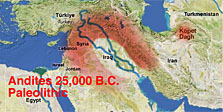 The Birth of the Andites
The Birth of the Andites
"The earliest Andite peoples took origin in the regions adjacent to Mesopotamia more than twenty-five thousand years ago and consisted of a blend of Adamites and Nodites." Kopet Dagh, the location of the "3rd Eden" home of Adamson and Ratta. This is a secondary location for the leaven of the later eastern expansion of the Mesopotamian Andites. Click on image for a larger view.
 Migrations of the Andites
Migrations of the Andites
It was about 15,000 B.C. when a great renaissance of the Garden culture was carried out to Eurasia and North Africa.
"Later on, when the migrating Adamites and Nodites entered the then fertile regions of Turkestan[now Turkmenistan], they soon blended with the superior inhabitants, and the resultant race mixture extended the Andite type northward." (Urantia Book p. 871-2) "From Mesopotamia through Sinkiang [now known as the location of the Tarmin Basin north of Tibet] the Andite culture was dominant, and the steady migration toward Europe was continuously offset by new arrivals from Mesopotamia. ...The civilization of Turkestan was constantly being revived and refreshed by the newcomers from Mesopotamia, especially by the later Andite calverymen. The so-called Aryan mother tongue was in the process of formation in the highlands of Turkestan; it was a blend of the Andonic dialect of that region with the language of the Adamsonites and later Andites. Many modern languages are derived from this early speech of these central Asian tribes who conquered Europe, India, and the upper stretches of the Mesopotamian plains. This ancient language gave the Occidental tongues all of that similarity which is called Aryan." (Urantia Book p. 872) In this age of political correctness this tongue is now called Indo-European.
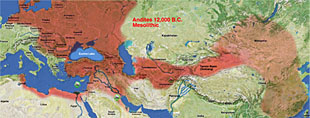 "By 12,000 B.C. three quarters of the Andite stock of the world was resident in northern and eastern Europe, and when the later and final exodus from Mesopotamia took place, sixty-five per cent of these last waves of emigration entered Europe." (Urantia Book p. 872-3)
"By 12,000 B.C. three quarters of the Andite stock of the world was resident in northern and eastern Europe, and when the later and final exodus from Mesopotamia took place, sixty-five per cent of these last waves of emigration entered Europe." (Urantia Book p. 872-3)
"The migratory conquests of the Andites continued on down to their final dispersions, from 8000 to 6000 B.C....They were skillfull domesticators of animals and expert agriculturists. For the time being, at least, their presence usually improved the religious beliefs and moral practices of the older races." (Urantia Book p.873)
These final emigrations from Mesopotamia went north in their largest number via the Caspian sea. Of this northern trek a small number went east into Sinkiang. Another small group went east into today's Iran and then into Turkmenistan. Yet another small group went west to Egypt. Only five per cent remained in the southern most part of Mesopotamia but these culturally superior Andites would become the seed of the later appearing Sumerians.
It should be remembered when looking at these maps that as the Andites spread out from Mesopotamia, that early man collectively was already there having had over half a million years to populate these lands. There was a continual movement of Andites from Mesopotamia and all evidences of civilization were carried from the epicenter of the Garden of Eden and Nodite culture. In these migrating waves were the Sethite priests who were taught by Seth one of the sons of Adam and Eve. I think it would be fair to attribute much of these fables, gods and history of Eden to these Sethite priests. So Andite culture was being overlaid atop the old Paleolithic stone age culture, uplifting and advancing it in preparation for the coming of civilization. And the Andite's inventiveness did not halt until after civilization appeared and they were quietly absorbed into the many faces of mankind. With the passing of the Andites no longer would the bloodline of the Adamites and Nodites be available to up step the peoples of the planet.
(Chick here to return to First Legend page.)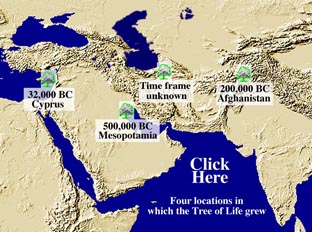 Locations of the Tree of LifeThe image to the left shows the four locations where the Tree of Life grew. The first is in the southern most area of what would become Mesopotamia. It is where the celestials first touched down. It was here they built the first city of Dalamatia that the Andites would later build Dilmun in remembrance of it. The Tree of Life was brought to the planet with the prince’s arrival. The fruit of the tree was sustenance for the 100 materialized members and the 100 modified Andonites. When eaten it could extend indefinitely their mortal existence. When the Lucifer rebellion began, loyal cherubim and seraphim took possession of it and allowed only the loyalist to partake of its fruit and leaves. When Van and Amadon left for the northern part of Afghanistan they took the tree with them and guarded it for the next 150,000 years. But apparently they did not stay in this part of Central Asia. At some point they moved to a new location near the Kopet Dagh. The Urantia Book does not state directly that Van and Amadon lived in the Kopet Dagh but there is a reference that this is so.
Locations of the Tree of LifeThe image to the left shows the four locations where the Tree of Life grew. The first is in the southern most area of what would become Mesopotamia. It is where the celestials first touched down. It was here they built the first city of Dalamatia that the Andites would later build Dilmun in remembrance of it. The Tree of Life was brought to the planet with the prince’s arrival. The fruit of the tree was sustenance for the 100 materialized members and the 100 modified Andonites. When eaten it could extend indefinitely their mortal existence. When the Lucifer rebellion began, loyal cherubim and seraphim took possession of it and allowed only the loyalist to partake of its fruit and leaves. When Van and Amadon left for the northern part of Afghanistan they took the tree with them and guarded it for the next 150,000 years. But apparently they did not stay in this part of Central Asia. At some point they moved to a new location near the Kopet Dagh. The Urantia Book does not state directly that Van and Amadon lived in the Kopet Dagh but there is a reference that this is so.
"Adamson was among that group of children of Adam and Eve who elected to remain on earth with their father and mother. Now this eldest son of Adam had often heard from Van and Amadon the story of their highland home in the north, and sometime after the establishment of the second garden he determined to go in search of this land of his youthful dreams...
A company of twenty-seven followed Adamson northward in quest of these people of his childhood fantasies. In a little over three years Adamson's party actually found the object of their adventure, and among these people he discovered a wonderful and beautiful woman, twenty years old, who claimed to be the last pure-line descendant of the Prince's staff. This woman, Ratta, said that her ancestors were all descendants of two of the fallen staff of the Prince." (Urantia Book p. 861)
"The Adamonites maintained a high culture for almost seven thousand years from the times of Adamson and Ratta. Later on they became admixed with the neighboring Nodites and Andonites and were also included among the "mighty men of old." And some of the advances of that age persisted to become a latent part of the cultural potential which later blossomed into European civilization.
This center of civilization was situated in the region east of the southern end of the Caspian Sea, near the Kopet Dagh. A short way up in the foothills of Turkestan are the vestiges of what was onetime the Adamsonite headquarters of the violet race." (Urantia Book p. 862)
So, much later the tree would finally be replanted from the Kopet Dagh area to the Cyprus peninsula where the first Garden of Eden was located. It took only 105 years for the Garden's demise. After the default, Adam and Eve were not allowed to carry the tree to the second garden. The tree was now unprotected at this time and burned by Nodites warring among themselves. Since the system circuits were now suspended, they were unable to benefit from the age defying properties of its fruit. With this destruction of the Tree of Life no longer would any personality be able to suspend the natural course of mortal existence. Scholars suspect that the Garden of Eden was located between the Tigris and Euphrates rivers. That is partially correct. It was the location of the second Garden that Adam and Eve created after their default. Because of close locations of these three epical events - the arrival of celestials, the Lucifer rebellion and the establishment of the second Garden - and the enormous time frame in which they transpired, these legends became admixed.
But the Tree of Life would live on in legend. Its history was part of Andite culture that spread around the world. Even the Mother Earth Goddess and the serpent survived. That is quite remarkable considering the length of time these events took place. Even now in the twenty first century these three icons from our distant past are still common knowledge.
 The Birth of the Andites
The Birth of the Andites"The earliest Andite peoples took origin in the regions adjacent to Mesopotamia more than twenty-five thousand years ago and consisted of a blend of Adamites and Nodites." Kopet Dagh, the location of the "3rd Eden" home of Adamson and Ratta. This is a secondary location for the leaven of the later eastern expansion of the Mesopotamian Andites. Click on image for a larger view.
 Migrations of the Andites
Migrations of the AnditesIt was about 15,000 B.C. when a great renaissance of the Garden culture was carried out to Eurasia and North Africa.
"Later on, when the migrating Adamites and Nodites entered the then fertile regions of Turkestan[now Turkmenistan], they soon blended with the superior inhabitants, and the resultant race mixture extended the Andite type northward." (Urantia Book p. 871-2) "From Mesopotamia through Sinkiang [now known as the location of the Tarmin Basin north of Tibet] the Andite culture was dominant, and the steady migration toward Europe was continuously offset by new arrivals from Mesopotamia. ...The civilization of Turkestan was constantly being revived and refreshed by the newcomers from Mesopotamia, especially by the later Andite calverymen. The so-called Aryan mother tongue was in the process of formation in the highlands of Turkestan; it was a blend of the Andonic dialect of that region with the language of the Adamsonites and later Andites. Many modern languages are derived from this early speech of these central Asian tribes who conquered Europe, India, and the upper stretches of the Mesopotamian plains. This ancient language gave the Occidental tongues all of that similarity which is called Aryan." (Urantia Book p. 872) In this age of political correctness this tongue is now called Indo-European.
 "By 12,000 B.C. three quarters of the Andite stock of the world was resident in northern and eastern Europe, and when the later and final exodus from Mesopotamia took place, sixty-five per cent of these last waves of emigration entered Europe." (Urantia Book p. 872-3)
"By 12,000 B.C. three quarters of the Andite stock of the world was resident in northern and eastern Europe, and when the later and final exodus from Mesopotamia took place, sixty-five per cent of these last waves of emigration entered Europe." (Urantia Book p. 872-3)"The migratory conquests of the Andites continued on down to their final dispersions, from 8000 to 6000 B.C....They were skillfull domesticators of animals and expert agriculturists. For the time being, at least, their presence usually improved the religious beliefs and moral practices of the older races." (Urantia Book p.873)
These final emigrations from Mesopotamia went north in their largest number via the Caspian sea. Of this northern trek a small number went east into Sinkiang. Another small group went east into today's Iran and then into Turkmenistan. Yet another small group went west to Egypt. Only five per cent remained in the southern most part of Mesopotamia but these culturally superior Andites would become the seed of the later appearing Sumerians.
It should be remembered when looking at these maps that as the Andites spread out from Mesopotamia, that early man collectively was already there having had over half a million years to populate these lands. There was a continual movement of Andites from Mesopotamia and all evidences of civilization were carried from the epicenter of the Garden of Eden and Nodite culture. In these migrating waves were the Sethite priests who were taught by Seth one of the sons of Adam and Eve. I think it would be fair to attribute much of these fables, gods and history of Eden to these Sethite priests. So Andite culture was being overlaid atop the old Paleolithic stone age culture, uplifting and advancing it in preparation for the coming of civilization. And the Andite's inventiveness did not halt until after civilization appeared and they were quietly absorbed into the many faces of mankind. With the passing of the Andites no longer would the bloodline of the Adamites and Nodites be available to up step the peoples of the planet.
(Chick here to return to First Legend page.)
 Locations of the Tree of LifeThe image to the left shows the four locations where the Tree of Life grew. The first is in the southern most area of what would become Mesopotamia. It is where the celestials first touched down. It was here they built the first city of Dalamatia that the Andites would later build Dilmun in remembrance of it. The Tree of Life was brought to the planet with the prince’s arrival. The fruit of the tree was sustenance for the 100 materialized members and the 100 modified Andonites. When eaten it could extend indefinitely their mortal existence. When the Lucifer rebellion began, loyal cherubim and seraphim took possession of it and allowed only the loyalist to partake of its fruit and leaves. When Van and Amadon left for the northern part of Afghanistan they took the tree with them and guarded it for the next 150,000 years. But apparently they did not stay in this part of Central Asia. At some point they moved to a new location near the Kopet Dagh. The Urantia Book does not state directly that Van and Amadon lived in the Kopet Dagh but there is a reference that this is so.
Locations of the Tree of LifeThe image to the left shows the four locations where the Tree of Life grew. The first is in the southern most area of what would become Mesopotamia. It is where the celestials first touched down. It was here they built the first city of Dalamatia that the Andites would later build Dilmun in remembrance of it. The Tree of Life was brought to the planet with the prince’s arrival. The fruit of the tree was sustenance for the 100 materialized members and the 100 modified Andonites. When eaten it could extend indefinitely their mortal existence. When the Lucifer rebellion began, loyal cherubim and seraphim took possession of it and allowed only the loyalist to partake of its fruit and leaves. When Van and Amadon left for the northern part of Afghanistan they took the tree with them and guarded it for the next 150,000 years. But apparently they did not stay in this part of Central Asia. At some point they moved to a new location near the Kopet Dagh. The Urantia Book does not state directly that Van and Amadon lived in the Kopet Dagh but there is a reference that this is so."Adamson was among that group of children of Adam and Eve who elected to remain on earth with their father and mother. Now this eldest son of Adam had often heard from Van and Amadon the story of their highland home in the north, and sometime after the establishment of the second garden he determined to go in search of this land of his youthful dreams...
A company of twenty-seven followed Adamson northward in quest of these people of his childhood fantasies. In a little over three years Adamson's party actually found the object of their adventure, and among these people he discovered a wonderful and beautiful woman, twenty years old, who claimed to be the last pure-line descendant of the Prince's staff. This woman, Ratta, said that her ancestors were all descendants of two of the fallen staff of the Prince." (Urantia Book p. 861)
"The Adamonites maintained a high culture for almost seven thousand years from the times of Adamson and Ratta. Later on they became admixed with the neighboring Nodites and Andonites and were also included among the "mighty men of old." And some of the advances of that age persisted to become a latent part of the cultural potential which later blossomed into European civilization.
This center of civilization was situated in the region east of the southern end of the Caspian Sea, near the Kopet Dagh. A short way up in the foothills of Turkestan are the vestiges of what was onetime the Adamsonite headquarters of the violet race." (Urantia Book p. 862)
So, much later the tree would finally be replanted from the Kopet Dagh area to the Cyprus peninsula where the first Garden of Eden was located. It took only 105 years for the Garden's demise. After the default, Adam and Eve were not allowed to carry the tree to the second garden. The tree was now unprotected at this time and burned by Nodites warring among themselves. Since the system circuits were now suspended, they were unable to benefit from the age defying properties of its fruit. With this destruction of the Tree of Life no longer would any personality be able to suspend the natural course of mortal existence. Scholars suspect that the Garden of Eden was located between the Tigris and Euphrates rivers. That is partially correct. It was the location of the second Garden that Adam and Eve created after their default. Because of close locations of these three epical events - the arrival of celestials, the Lucifer rebellion and the establishment of the second Garden - and the enormous time frame in which they transpired, these legends became admixed.
But the Tree of Life would live on in legend. Its history was part of Andite culture that spread around the world. Even the Mother Earth Goddess and the serpent survived. That is quite remarkable considering the length of time these events took place. Even now in the twenty first century these three icons from our distant past are still common knowledge.

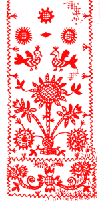
 Art, Language and Culture
Art, Language and CultureOne of the earliest settlements of mankind is the Cucuteni-Trypillian culture in Moldova, Romania and the Ukraine (the earliest we know of is Catalhoyuk, southern Turkey 6200-5700 BC). Located northwest of the Black Sea this area is now being referred to as part of the Old Europe dating back to 5500 BC. This term Old Europe was coined by archaeologist Marija Gimbutas and is synonymous with Neolithic Europe and Pre-Indo-European. Among artifacts unearthed are images of the Tree of Life and the ever pervasive figurines of the Earth Mother. The image of the Tree of Life along with others from the ancient Neolithic are still a part of traditional folk art in this region today. Click on bowl for a larger image.
There are two important things about this culture that marks it as Andite. First is evidence of the domestication of the horse. The Urantia Book states that the Andites were the first to do so. Second are the many goddess figurines found buried through out this region. The Urantia Book also states that the Andites worshiped the Mother Earth goddess. They had a crude and elementary system of writing. At least by our standards. Linguists have determined that there are some words related to Sumerian although these early scripts are open to speculation. This script maybe related to the Danube script which at this point is not very well understood. Both of these assumptions are most likely correct. It should be remembered that the neighboring Hungarians believe that they too are related to the Sumerians and that the Hungarian language helped decode and translated the cuneiform tablets. The C-T culture was experimenting with agriculture and metal, copper in particular. "Copper metallurgy was first introduced into east central Europe by 5500 BC, and clearly has a long and relatively unknown pedigree amongst the Old European homelands north of the Black Sea. Linguistically the vocabulary of metallurgy provides some evidence of the antiquity of smelting tradition. Where a root word exists in multiple languages, it is generally accepted as evidence of its antiquity." (http://www.gizagrid.com/egyptian_iron.html © Keith Squires 2005)
 The worship of the Great Goddess, the Earth Mother, was by the time of the Neolithic becoming dominated by the male gods. In Sumeria the goddess became Inanna and remained a potent figure of worship and power. The veneration of the Tree of Life continued on finding expression in both stone reliefs and palatial murals. As these Andites migrated out from the alluvial plains of the Tigris and Euphrates every culture that grew up in their wake echoed their reverence for the Tree of Life. The four above Venuses are Gravettian named after a region in France. This culture from 28,000 to 22,000 BC is Upper Paleolithic which includes much of central Europe and Russia. These four are named from left to right: Venus of Vestonice Dolni (Czech Republic), Venus of Willendorf (Vienna, Austria), Venus of Lespugue (France) and the Venus of Laussel (Dordogne, France). All date to after the establishment of Eden.
The worship of the Great Goddess, the Earth Mother, was by the time of the Neolithic becoming dominated by the male gods. In Sumeria the goddess became Inanna and remained a potent figure of worship and power. The veneration of the Tree of Life continued on finding expression in both stone reliefs and palatial murals. As these Andites migrated out from the alluvial plains of the Tigris and Euphrates every culture that grew up in their wake echoed their reverence for the Tree of Life. The four above Venuses are Gravettian named after a region in France. This culture from 28,000 to 22,000 BC is Upper Paleolithic which includes much of central Europe and Russia. These four are named from left to right: Venus of Vestonice Dolni (Czech Republic), Venus of Willendorf (Vienna, Austria), Venus of Lespugue (France) and the Venus of Laussel (Dordogne, France). All date to after the establishment of Eden.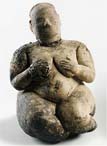

 To the far left the Goddess from Gobleki Tepe (east of Catalhoyuk) Anatolia 9,000 B.C.
To the far left the Goddess from Gobleki Tepe (east of Catalhoyuk) Anatolia 9,000 B.C.Middle the Goddess from the Halaf period Mesopotamia 7,000 B.C.
To the near left the Goddess from Sumeria, Inanna "Queen of Heaven" 3,000 B.C.

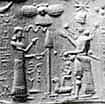
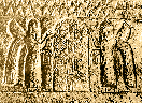 To the far left the Babylonian Tree of Life in stone relief Palm styleMiddle a Sumerian cylinder impression with genii, a god (or goddess), Tree of Life, serpent and the solar winged disk
To the far left the Babylonian Tree of Life in stone relief Palm styleMiddle a Sumerian cylinder impression with genii, a god (or goddess), Tree of Life, serpent and the solar winged diskTo the left the Urartian Tree of Life with attending genii picking the fruit. Click on the image for a larger view.


 Assyrian Tree of Life with two geniis and King Ashurnasirpal.
Assyrian Tree of Life with two geniis and King Ashurnasirpal.From the Northwest palace at Nimrud. Click on image for a larger view.The Vanites were the ancestors of the Assyrians (Urantia Book p. 860) whose main religious symbol was the Tree of Life. The civilization of Urartu located in Turkey at Lake Van (highlands of Armenia) made many images of the two genii picking the fruit of the Tree of Life. The Sumerians, of course, had a very strong connection to the Tree of Life as well. The Tree of Life also known as the “sacred tree” made its way into Babylonian and Assyrian religious beliefs and related cultures of the region. It comes as no surprise that the tree would have such a large impact on the history of the region. It sustained the gods and grew for about 450,000 years. The Babylonians who conquered Akkad were also of Andite ancestry and assimilated the Sumerian culture and language. The empires of Assyria and Babylon were very close on the time line. The old Babylon empire was from 2000-1600 BC and the Assyrian empire was from about 2000-612 BC. The smaller tan illustration is a detail of one of the leafs or fruit in the Palm style.
"The oldest name of Babylon, Tin-tir-ki, meant ‘the place of the tree of life’.
• The name Euphrates was applied to the rope of the world, to the encircling river of the snake god of the tree of life, to the heavenly river which surrounds the earth (Sumerian)."
